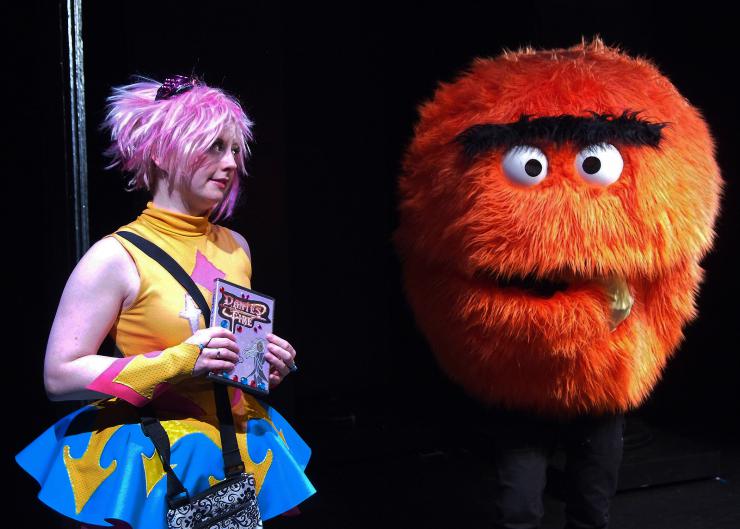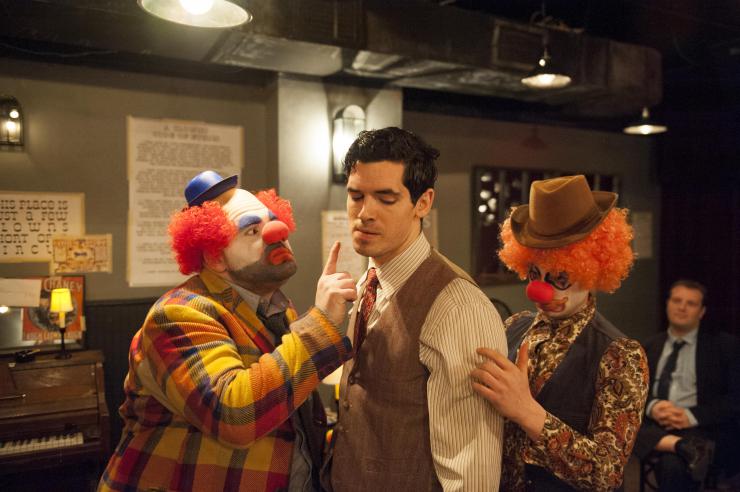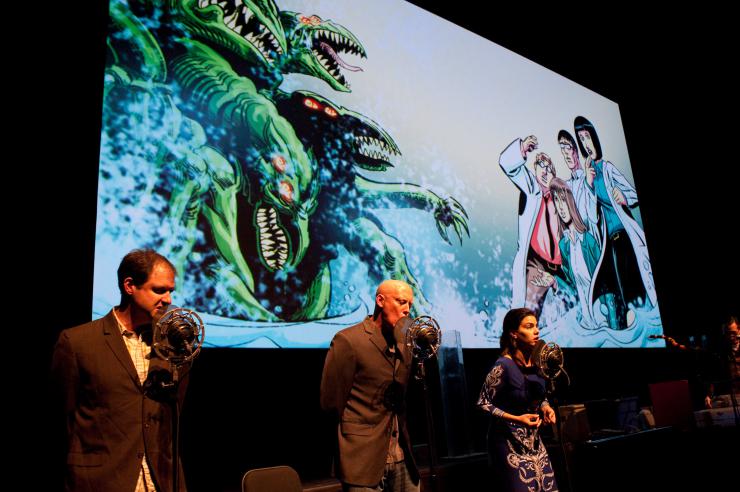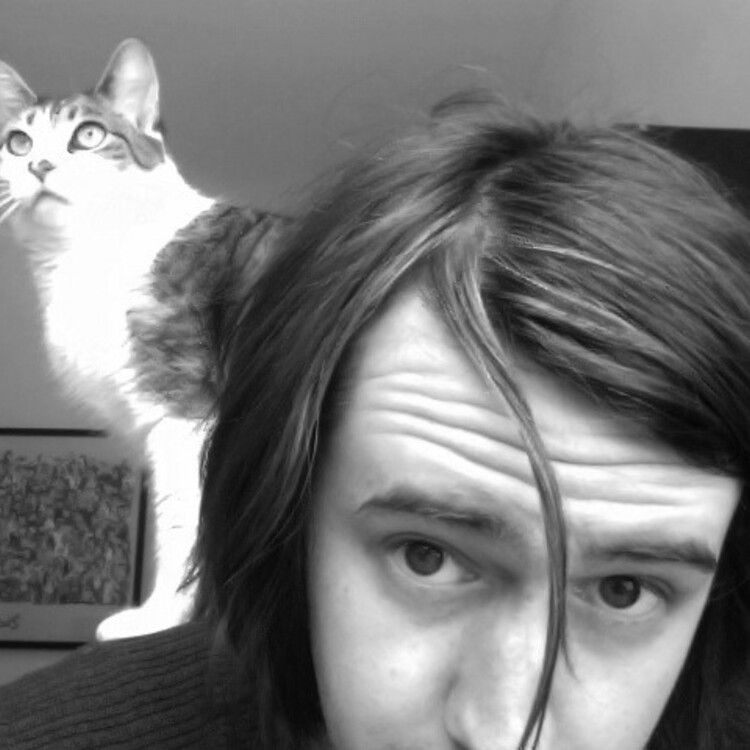Soaring Geeks, Gangster Clowns, and Sludge Villains

Late in Crystal Skillman's Geek!, two high school girls grapple on a windowsill. One falls out, and the other leaps after her—a feat of superhero valor from a character with no superpowers. Her friends follow, including one who is in costume as a plushball Pac-Man-like creature named Squeaker. About fifteen feet from the pavement, just when leaping out of windows is starting to seem like a bad idea, Squeaker starts to fly. Perched on his ten-foot-long wings, the falling girls soar, woo-hooing like the kids in E.T. The audience soars along with them.
(See an interview on HowlRound with Crystal Skillman here.)
Here is grand spectacle on a limited budget, a few seconds of gravity-defying joy tempered by the moment of terror experienced as the characters fall. It is everything that is wonderful about geek theatre, an Off-Broadway subgenre that has become increasingly mainstream over the last ten years. This spring, three plays opened in New York that could fall under the term’s umbrella: Geek, Clown Bar, and The Intergalactic Nemesis: Part 1. Each aimed to be a giddy good time, succeeding based on how willing the creators were to grapple with their story’s dark side—that horrible moment when fantasy is not real, and the characters are about to hit the ground.
...two high school-age manga aficionados venture to a comic-con to meet their idol and exorcise their demons.
In Geek, which ran from March 21 to April 13 at the Incubator Arts Project, two high school-age manga aficionados venture to a comic-con to meet their idol and exorcise their demons. In school, Danya and Honey are exiles, but for years they have found solace by obsessing over the anime epic Dante’s Fire, a fandom they express by dressing up as their favorite characters and acting out scenes from the story. The third member of the gang is Ellen—Danya’s friend, Honey’s sister—but she does not make it to the convention. Ellen has killed herself, and Danya, unable to cope with the funeral, decides that she and Honey are going to the Dante’s Fire Con anyway, on a half-baked quest to meet the manga’s creator. Standing in their way is an army of cosplayers, armed with cardboard swords and intimate knowledge of arcane Dante’s Fire trivia. The devil cats, minotaurs, and steam punk soldiers can be dispatched with swordplay, but for Danya and Honey, dispelling their grief will take more than swashbuckling.
Produced by geek theatre granddaddies Vampire Cowboys, Geek features all of the kung-fu slickness and emotional honesty for which that company, and its main playwright, Qui Nguyen, has become famous. I love the Vampire Cowboys style—anyone who stages a samurai swordfight six feet in front of my face is fine by me—but I sometimes find their work tries harder than necessary to make us care for the characters. Nguyen writes loud plays, full of banter, dance music, and rapid-fire pop culture references, and there are times when his characters have to shout to keep up—rehashing their emotional motivation until their pain becomes stale.
I worried Geek might suffer from the same problem. From the first scene, it’s clear that Danya has come to the con to avoid dealing with her grief and the responsibility she feels—rightly or wrongly—for her friend’s suicide. As motivation, this is potent enough that it should be handled carefully. Instead, as though afraid Danya’s emotional conflict might not be heard over the fray of battle, Skillman restates it several times. By the time the play is over, Danya has been called selfish so often that, when she finally realizes she’s been a lousy friend, the only surprise is that she didn’t catch on sooner.
Happily, we have Honey to save the day. Both in and out of their costumes, Honey is Danya’s sidekick, ready to follow wherever the older girl leads. But she is also the one whose sister has died, and carries pain she does not show until the play is nearly finished. Alone with Squeaker, Danya nowhere to be seen, Honey tells the story of her sister’s suicide in language as naturally heartbreaking as the rest of the play is madcap and absurd. As Honey, Becky Byers carries the scene beautifully, creating an interpersonal moment that’s every bit as beautiful as the one where three girls learn they can fly. Her pain makes the play wonderful—like a bit of salt that keeps an otherwise airy confection from being toothache sweet.

Honey is an angry girl who forces herself to wear a smile. The villains of Adam Szymkowicz’s Clown Bar, on the other hand, are vicious fiends whose smiles are only painted on. Meet Dusty, Twinkles, Giggles, Bobo, and the rest of the crew—an ensemble of gangsters with red noses, oversized bow ties, and size 33 shoes that they’ll kill you for stepping on. This is the “underground clown crime world,” where a person is as likely to catch a stomachful of lead as a faceful of seltzer.
Outside the theatre, a clown nose-wearing waitress takes orders for drinks.
Staged in the cramped performance space at the back of the Lower East Side’s Parkside Lounge, Clown Bar ran from March 1 to April 12, and was produced by Pipeline Theatre Company, a four year-old group specializing in slick, seemingly effortless comedy. Clown Bar sucks in its audience even before they take their seats. Outside the theatre, a clown nose-wearing waitress takes orders for drinks. Order a beer, and she’ll warn you, “The production is just over an hour. Are you sure you don’t want two?” The man behind me seemed to understand that this was meant to be a fun play—he ordered three beers and a shot of whiskey, just the recipe for a Clown Bar state of mind.
This is a boozy, drug addled, manic-depressive romp starring seven or eight of the most tortured clowns you’ve ever seen. Our hero is Happy, the least happy clown of all. A onetime big top star who traded his white face for a detective’s shield, he has returned to this den of hilarious sin to learn who killed his kid brother Timmy, a troubled clown who was never quite funny enough for the big time. Like Danya and Honey, Happy has come to face his demons, and he doesn’t mind hurting anyone who gets in his way.
Though brief, the play is dense, crammed full of lush music, burlesque, and a series of rat-a-tat clown gags with names like “the invisible slug,” “fat foot,” and “trouble at the Sistine Chapel.” There are also quite a few of what the program describes as “very close very loud gunshots,” accompanied not by stage blood, but bursts of confetti that fly to the ceiling as clown after clown dies. This is a serious yarn, and the actors treat it as such, no matter how big their bow ties may be. If the first rule of geek theater is to sprinkle an upbeat show with at least a pinch of pain, the second is nearly as important: never blink.
These are two places where The Intergalactic Nemesis falls short for me. In this live-action radio play, a pair of reporters and a time-traveling librarian travel the stars in order to save mankind from a ferocious race of sludge-creatures. Along the way, they ride horses, sock jaws, walk down stone hallways, and do other things that can be rendered in excellent, often hilarious Foley sound. (In case you were wondering, a toy cement mixer sounds just like a robot.) Though lively, Nemesis lacks the sentiment that underlies Clown Bar and Geek. Its characters are deliberately flat, their emotions not taken seriously, their death scenes played for laughs. The play, which ran from April 1 to April 13, is two-fisted, primary color fun, and there’s nothing wrong with that. But I think it could have been more.
Its universe-trotting script—which starts in the Carpathian mountains and passes through Scotland and Tunisia before heading to the stars—is more polished than Clown Bar or Geek, and it should be, since writer, director, and producer Jason Neulander has been working on this story, in one form or another, since 1996. (A second installment is planned for next year.) The script is a crowd-pleaser, and I imagine that in the environment where it was first staged—a coffee shop back room not unlike Clown Bar’s venue—it would have been electric. But in a Broadway house, the radio drama’s cozy charm gets lost.

When he began touring with it in 2009, Neulander commissioned artist Tim Doyle to create a comic book version of the show which could be played behind the three voice actors as the story spins along. Rather than supporting the story, the images often tell us less about what’s happening in a scene than the actors could do with body language alone. This is not the fault of the often-striking art, but simply a fact of theater: it’s more fun to watch live actors than still images. The audience’s attention is split between stilted drawings and animated actors, and without extreme focus, the magic of radio fizzles away.
I should note that The Intergalactic Nemesis played at the New Victory Theater, which specializes in kid-friendly entertainment. When I saw it, the auditorium was full of very hip looking children, none of whom seemed bothered by the show’s ironic take. During intermission, I heard two young boys quoting the show to each other—an undeniable sign of success. But some of the best children’s entertainment contains a touch of sadness—remember Up, or Charlotte’s Web—and the threatened destruction of Earth might deserve a moment of gravity.
The Intergalactic Nemesis is a science fiction play, the same as Geek is an adventure story, and Clown Bar is hard-boiled noir. All are funny, all are fun, all do things with their genres that I have never seen on stage before. But to stage a clever play with no emotional underpinning is to give in to the argument that genre fiction can’t be art. Thankfully, we have Geek and Clown Bar, with their gravity-defying cosplayers and dying, confetti-covered clowns, to remind us that there is such a thing as serious fun.








Comments
The article is just the start of the conversation—we want to know what you think about this subject, too! HowlRound is a space for knowledge-sharing, and we welcome spirited, thoughtful, and on-topic dialogue. Find our full comments policy here